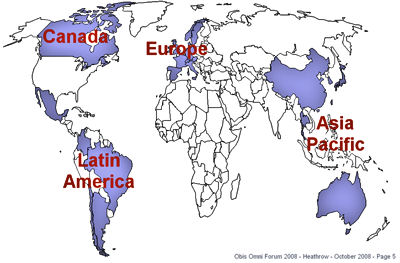I am again indebted to a question raised on the LinkedIn.com Business Intelligence Professionals group for this article. The specific thread may be viewed here and the question was the beguilingly simple “How to understand BI requirements in an organisation?”
Background
I have previously written about some aspects of successfully achieving this in a European environment, but thought that it would be interesting to add my thoughts about doing the same thing more recently on a wider international scale.
[A note here, in common with many US-based companies, “international” means all non-US markets; in my case: Asia Pacific, Europe, Canada and Latin America. By way of contrast “global” means international plus the US domestic market, i.e. all operations.]
By way of providing some context, in previous years I had successfully built and deployed an Information Architecture for the European operations of a multinational Insurance organisation and extended components of this to our Latin American subsidiaries. I had also deployed the same corporation’s financial system to its Asia Pacific business. …
| Business Intelligence Professionals | |||
Introduction
I am again indebted to a question raised on the LinkedIn.com Business Intelligence Professionals group for this article. The specific thread may be viewed here and the question was the beguilingly simple “How to understand BI requirements in an organisation?”
Background
I have previously written about some aspects of successfully achieving this in a European environment, but thought that it would be interesting to add my thoughts about doing the same thing more recently on a wider international scale.
[A note here, in common with many US-based companies, “international” means all non-US markets; in my case: Asia Pacific, Europe, Canada and Latin America. By way of contrast “global” means international plus the US domestic market, i.e. all operations.]
By way of providing some context, in previous years I had successfully built and deployed an Information Architecture for the European operations of a multinational Insurance organisation and extended components of this to our Latin American subsidiaries. I had also deployed the same corporation’s financial system to its Asia Pacific business. My track-record in adding value through BI and my exposure to two major projects in the international arena led to me being asked to build on the European technology assets to develop a management information strategy for the four international regions. This article is about how I succeeded in doing this.
Consistent with the general approach that I laid out in an earlier article, my two first objectives were to understand the needs of the various business groups across the four international regions and to form a high-level picture of the IT architecture in these areas. Although I pursued these twin goals in tandem, it was the business piece that I placed most emphasis on initially. It is this area that I will have most to say about here.
Understanding the business
The way that I approached my goal of learning about the international business was not novel in any aspect except possibly its scale. As you would expect, I did it by speaking to business managers from different countries and business units in each of Asia Pacific, Canada, Europe (I revisited the European requirements to make sure I was not neglecting these), Latin America and people with international or global responsibilities.
Some of these interviews were face-to-face, but – given the geographic spread of my correspondents – the bulk of them were over the ‘phone. The many time-zones involved provided another challenge. I am based in the UK and it was not atypical to be on the ‘phone talking to Australia or Singapore at 6am my time; pick up on some European meetings during the morning; talk to Canada, Latin America and the US parent during the afternoon and evening; and be back on the ‘phone to Australia at midnight. There were a lot of these 14-hour plus days!
One thing that I was surprised by in the process was how well it worked being on the ‘phone. Although I sometimes find it a lot easier to be speaking in person, being able to pick up on visual cues and so one, using the telephone both allowed me to listen vary carefully to what was being said and to take detailed notes; it is tough taking detailed notes while maintaining eye-contact of course. I structured the interviews to explore the following areas:
- An overview of the manager’s markets, products, structure, strategy, growth areas and any pressing business challenges
- Their thoughts on the general IT infrastructure available to them; looking beyond what some people might view as the world of management information
- The extent and quality of their current MI, including local and corporate reporting systems and even any Access databases and spread-sheets; here I placed particular emphasis on any major gaps
- What their vision was for improved MI facilities; an ideal state for MI if you will
This proved to be a successful approach and I learnt a remarkable amount about the differences between countries and markets. I normally allowed 30 minutes for these calls, suggesting in my introductory e-mail that if people were pressed for time, 15 might suffice. No call was ever less than half-an-hour long, most of them expanded to be an hour or more, such was the interest generated by my line of questioning.
The scale of the work
I had initially targeted speaking to around 40-50 managers, but quickly came to realise that – given the diversity of the organisation’s operations – I would need to talk to more people to get an accurate picture. As things worked out, I ended up interviewing precisely 100 managers. I started to try to describe the range of people that I talked to and quickly came to the conclusion that a picture paints a thousand words. The following exhibit provides a breakdown by geographic span of responsibility and area of the business:
The paper covering their detailed feedback from this exercise expanded to over 400 pages; each line of which was reviewed, sometimes amended, and signed-off by the people interviewed. Such a sign-off process certainly increases the duration of the work, but it is indispensable in my opinion. If you are inaccurate or incomplete in your understanding of the business, then you are building on foundations of sand. Of course, as well as using this exhaustive process to document business requirements, it was also a great opportunity to begin to establish relationships and also to gently start the process of marketing some of my ideas about MI.
It is clearly inappropriate for me to share my detailed findings about the business issues that the organisation was dealing with, however I will make one observation, which I think is probably replicated in many companies. When I spoke to managers at different levels within the organisation, they all cited similar strategies, challenges and priorities. This fact was testament to good communication between different tiers, however widely separated by geography, and also to a shared sense of purpose. What was however notable was that people at different levels gave varying emphasis to the issues. If a global leader prioritised areas as 1-2-3-4, it was not unusual that a manager at the country level instead ranked the same areas as 1-4-3-2. Perhaps this is not so surprising.
Understanding the systems
In parallel I also worked with the CIOs of each region and with members of their departments to understand the systems that different business units used and how they were interrelated. In doing this, it was helpful to already have the business perspective on these systems and I was able to provide general feedback about IT in each territory which was valuable to my colleagues. In this type of work (as indeed can be the case when thinking about different markets and products from the business perspective) it is sometimes easy to be overwhelmed by the differences. Instead, I made myself focus on teasing out the similarities. There ended up being many more of these that I had anticipated. In this work I relied to a great extent on my experience of consolidating data from three different underwriting systems (plus many other back-end systems) as part of my previous work in Europe.
Forming and validating a strategy
With this substantial background in both the business needs and the IT landscape, I was able to develop a management information strategy that focused on what was held in common across business units and departments, whilst still recognising the need to meet certain market-specific requirements. The lengthy hours of research that I had put in proved to be worthwhile when I presented my ideas back to many of the same group that I had interviewed and received their backing and approval.
Some final thoughts
While it was undeniably interesting and even fun to learn so much about the diverse operations of a large international organisation, the process was undeniably lengthy sometimes even arduous. It took six months from conception of the project to delivering detailed findings, recommendations and plans to the international senior management team (of course I also presented interim findings and draft recommendations several times over this period).
It remains my firm belief that this type of exercise is mandatory if you are really serious about adding value with BI. I can see no way to short-cut the process without substantially compromising on your deliverables and the value that they are intended to unlock. If you do not understand the business and its needs, it is nigh on impossible to deliver the information that they require to take decisions. In some areas of life, you just have to put in the hard work. Establishing the requirements for BI in a large international organisation is certainly one of these areas.
Posted in business, business intelligence, enterprise performance management, international projects, it business alignment, management information, technology Tagged: bi, business intelligence, business strategy, information technology, it business alignment, it strategy, management information
![]()










